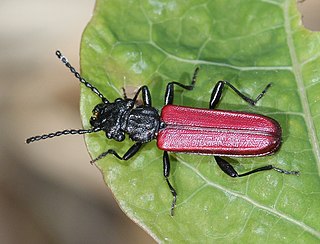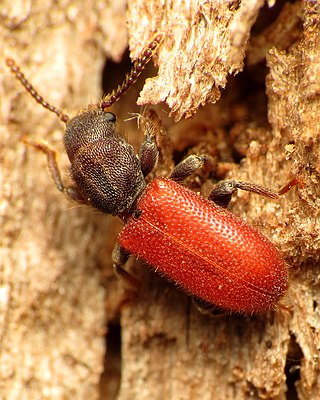
The longhorn beetles (Cerambycidae), also known as long-horned or longicorns, are a large family of beetles, with over 35,000 species described. Most species are characterized by extremely long antennae, which are often as long as or longer than the beetle's body. In various members of the family, however, the antennae are quite short and such species can be difficult to distinguish from related beetle families such as the Chrysomelidae. The scientific name of this beetle family goes back to a figure from Greek mythology: after an argument with nymphs, the shepherd Cerambus was transformed into a large beetle with horns.

The Archostemata are the smallest suborder of beetles, consisting 45 living species in five families. They are an ancient lineage with a number of primitive characteristics. Antennae may be thread-shaped (filiform) or like a string of beads (moniliform). This suborder also contains the only beetles where both sexes are paedogenic, Micromalthus debilis. Modern archostematan beetles are considered rare, but were more diverse during the Mesozoic. The term "Archostemata" is used more broadly by some authors to include both modern archostematans as well as stem-group beetles like "protocoleopterans", which some modern archostematans closely resemble to due to their plesiomorphic morphology. Genetic research suggests that modern archostematans are a monophyletic group. Some genetic studies have recovered archostematans as the sister group of Myxophaga.

The Cucujidae, "flat bark beetles," are a family of distinctively flat beetles found worldwide under the bark of dead trees. The family has received considerable taxonomic attention in recent years and now consists of 70 species distributed in five genera. It was indicated Cucujus species are scavengers, only feeding on pupae and larvae of other insects and on other subcortical beetles such as their own. Since the Cucujidae prey on larvae of potentially tree damaging beetles that spread fungal diseases, they are considered to be beneficial to the health of living trees.

Scarabaeoidea is a superfamily of beetles, the only subgroup of the infraorder Scarabaeiformia. Around 35,000 species are placed in this superfamily and some 200 new species are described each year. Its constituent families are also undergoing revision presently, and the family list below is only preliminary.

The Chrysomeloidea are an enormous superfamily of beetles, with tens of thousands of species. The largest families are Cerambycidae, long-horned beetles, with more than 35,000 species, and Chrysomelidae, leaf beetles, with more than 13,000 species.

Leiodidae is a family of beetles with around 3800 described species found worldwide. Members of this family are commonly called round fungus beetles due to the globular shape of many species, although some are more elongated in shape. They are generally small or very small beetles and many species have clubbed antennae.

Ptinidae is a family of beetles in the superfamily Bostrichoidea. There are at least 220 genera and 2,200 described species in Ptinidae worldwide. The family includes spider beetles and deathwatch beetles.

Georissus, also called minute mud-loving beetles, is the only genus in the beetle family Georissidae. They are tiny insects living in wet soil, often near water. They are found on every continent except Antarctica.

Anobiinae is a subfamily of death-watch beetles in the family Ptinidae, with at least 45 genera. It was formerly considered a member of the family Anobiidae, but its family name has since been changed to Ptinidae.
Anobium inexspectatum is a species of beetle in the family Ptinidae. It is native to Europe, its distribution extending to Azerbaijan. The larvae are found only on common ivy.
Hemicoelus canaliculatus is a species of death-watch beetle in the family Ptinidae.
Antonaria is a genus of beetles in the family Megalopodidae, containing the following species:
Cyrtocris fulvicornis is a species of beetle in the family Cerambycidae, and the only species in the genus Cyrtocris. It was described by Sven Magnus Aurivillius in 1904. It is known from Lukuledi River in Tanzania.
Stefano Ludovico Straneo was an Italian entomologist, teacher, academic administrator and author.
Hemicoelus carinatus is a species in the subfamily Anobiinae, in the order Coleoptera ("beetles"). The species is known generally as the "Eastern deathwatch beetle". It is found in North America.

Hemicoelus is a genus of death-watch beetles in the family Ptinidae. There are about 12 described species in Hemicoelus.
Spintherophyta is a genus of leaf beetles in the subfamily Eumolpinae. Most species in the genus are found in Central and South America, but there are also a few North American species.
Hemicoelus gibbicollis, known generally as California deathwatch beetle, is a species of death-watch beetle in the family Ptinidae. Other common names include the Pacific powder post beetle and western deathwatch beetle. It is found in North America.

Anobiini is a tribe of death-watch beetles in the family Ptinidae. There are at least 6 genera and 20 described species in Anobiini.

Thanerocleridae is a family of beetles belonging to the superfamily Cleroidea. It was formerly considered a subfamily of Cleridae, but was recently elevated to the rank of family. The family has 36 living species in 10 genera, which are found globally, mostly in low-latitude tropical regions, though the genus Zenodosus is found in temperate North America. Thaneroclerid species are likely all predatory both in adult and larval stages. They target small fungus and wood associated beetles, and are generally found in places where such beetles are likely to be found, typically tree associated habitats such as under bark, though some species occur in other locations such as termite nests.











